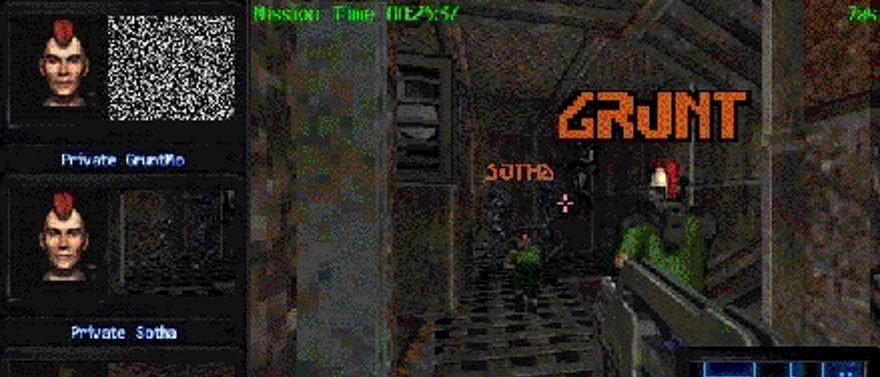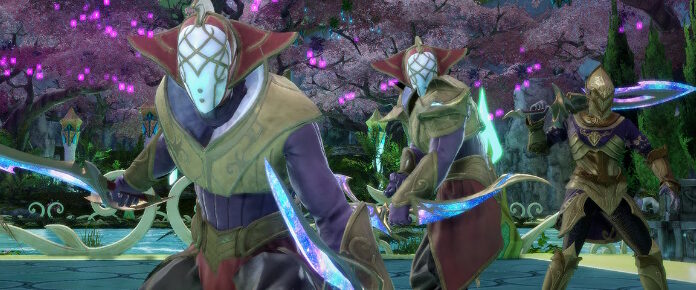
When you bring up the name “Mythic Entertainment,” chances are that most gamers are going to immediately think of the studio’s two major MMOs, Warhammer Online and Dark Age of Camelot. Perhaps Imperator Online might come into the conversation, perhaps not. But what is fascinating to me is that Mythic had a lot more than a pair of MMOs under its belt.
Since the formation of the studio in the mid-1990s, Mythic’s team developed well over a dozen titles, many of which featured online multiplayer and other elements that would eventually lead into the company releasing DAoC to widespread acclaim in 2001. I’ve been curious what these older titles were like and how they contributed to the formation of Mythic’s MMOs, and so rather than get all of my information from second-hand sources, I went straight to City State Entertainment’s Mark Jacobs to ask him about games like Aliens Online, Spellbinder, and Darkness Falls. Considering that the man is still working on spiritual successors to the games he was involved with decades ago, I thought it would be great to get his perspective.
The Game Archaeologist: So Mark, mostly I just wanted to cover your Mythic’s games leading up to Dark Age of Camelot. I’ve been doing a bit of reading up on all of them.
Mark Jacobs: We did make a lot of them.
One site credits Mythic with 17 games, does that sound right? Seventeen developed?
Sounds about right but I’d have to look at the list.
So tracing back to a starting point, would you say that Aradath marks a good beginning place to talk about the lead-up to Mythic and your games?
Well, it would be Galaxy and Gamer’s World actually. Galaxy was the first online game that I ever wrote. It was based on a game that friends of mine wrote in college (which in turn was based on a play-by-mail game). The game was a 4X, multiplayer online game that I used on Gamer’s World. Gamer’s World was a standalone online game service that I wrote in the ’80s based on the QNX operating system.
The second game I created for it was the world’s third MUD, Aradath, which was intended to create with a slightly earlier MUD and really fun game, The Scepter of Goth. Gamer’s World also had a rudimentary email and forums system which I also wrote. It worked off a bank of really slow modems and I ran it out of my apartment.
True story, when I tried to get the phone company to install nine phone lines, they balked for a while. They said that the only reason I could want so many phone lines was either because I was a drug dealer or running a brothel. I had to drag some people to my apartment to show them the game system in order for them to install all the phone lines I needed.
You might have made more money as a drug dealer.
LOL, I would have made more money working at a fast food restaurant. :)
So I’ve heard of Aradath but not much about what it was like. How did it distinguish itself from those other few MUDs? How many people ended up playing and what did you learn about making an online game from it?
Aradath was fundamentally different from Richard Bartle’s MUD 1 (which was the world’s first true MUD) in almost every way. As to The Scepter of Goth, Aradath could handle more people, was faster, and was a much deeper in most ways but was closer to that type of game than it was MUD 1. Both MUD 1 and Scepter were really great games for the time, and without them, I believe the online industry wouldn’t be where it is today.
As to learning a lot about making online games, my education about them started in college thanks to the above-mentioned friends I had there. Sadly, neither of them went into gaming. Both of them were way better programmers than me and one, Bill Pugh, was one of the smartest guys I ever met and Gary Lindstrom was a really good programmer and an amazingly creative guy. Both of them shaped my life in unexpected ways. I wished that they had gone into gaming, the industry would have been benefited from them.
It was my belief that there was a future in online gaming even though almost nobody in the world agreed with that opinion back then. As I’ve said in other interviews, I got laughed out of just about every meeting I had trying to push online games with the PC publishers back in the ’80s. I loved and still love online games and I don’t think we’ve scratched the surface of what they will become in the future.
So how did this lead into the formation of Mythic? Like-minded souls bumping into each other and going, “Heck yeah, let’s make online games?”
Sort of, but there was the in-between period of almost 10 years with A.U.S.I. (Adventures Unlimited Software Inc.) where I was putting games on services like GEnie and NVN (National Videotext Network). In the hopes of keeping this brief, I’ll simply say that until 1995, I was operating a number of games on commercial time-share services like Genie.
I got a call from my friend/fellow GULC attendee/lawyer James Dunstan. He said that a partner at his firm had a client who was dealing with a certain software company (name withheld because I won’t throw them under the bus). I told Jim that I would be happy to give that person, Robert Denton, my insight on them if he wanted it. The partner said that his client would be happy to talk to me about that company, and we got together for our first meeting. That led to a number of other meetings, including one where he told me I was wrong about this company, and what I predicted would happen, would never happen. Well, we walked away and less than a couple of months later, he came back and said that I was right.
That led to another series of meeting where I made some predictions, which he also disagreed with (centered around Rob’s company ability to land online game deals), and we walked away again. Well, a couple of months later he came back and once again said I was right, and that we should combine our companies, A.U.S.I. and I.S.I. (Interesting Systems Inc.) together. And after a number of other conversations, the departure of two of his partners and the addition of one who had walked away from I.S.I., the wonderful Matt Firor, we merged the companies and formed Interworld Productions.
A number of months later, we changed the name to Mythic Entertainment because there was another company in New York City that had filed for Interworld a couple of weeks before we did. And well, since we had very little money, we eventually settled with them and changed the name. And thus was Mythic Entertainment born.
What were some of the technological challenges of bringing a game online back in the 1990s?
Number one, bandwidth cost. In today’s world where bandwidth cost is a secondary cost for most MMORPGs, for us it was a big deal. Whether the game was going to be distributed via AOL, Kesmai’s Gamestorm, or Wanadoo’s GOA, we had to optimize the heck out of our network traffic to keep it as low as possible. Even in 2001, our contract with GOA contained incentives for the amount of bandwidth that we used. I think the contract for WAR might have even had that too, but I’m not 100% sure.
Second, server cost. Servers too were expensive back in the day. I’ve told the story about how Dell wouldn’t even allow us to lease servers from them, even though William Lauder (yes, of Estee Lauder) was willing to co-sign the lease! Dark Age of Camelot came perilously close to not launching due to that issue, rather than any software issue. One interesting side note was that when we needed additional servers to handle the unexpected demand for the game at launch, we were able to go down to our local Microcenter and buy some standard PCs and we plugged them into the network. They weren’t as powerful as our other servers but they functioned nicely. That is a testament to the superb engineering effort from the team that architected and coded the game.
Third, PC performance. Anybody remember what your typical PC looked like in 2001? Let’s take a trip down memory lane. Here’s a link to what your high-end rig in 2000 looked like. Impressive by the standards of the time, but man oh man, it wasn’t easy to pull off games like Aliens Online and Dark Age of Camelot back then. That’s something people should remember when they look at any game from different eras, especially if they are about to say, “Those graphics sucked!” :)
And fourth, local connectivity. OK, now that you remembered what PCs were like in 2001, now think back to those halcyon days of AOL’s carpet-bombing of disks for their wonderful service. ‘Nuff said.
So casting your mind back to the ’90s there, what were your favorite titles that Mythic produced during that period? I have some specific games I want to ask you about, but I’m curious which ones were your passion projects.
My favorite Mythic games, pre-Dark Age of Camelot, were Aliens Online, Silent Death Online and Rolemaster: Magestorm.
Aliens Online always caught my attention — I loved the movies but never knew about the game when I was in college. How popular was it? Was it simply an Aliens-themed online FPS?
For the time, it was reasonably popular. It was also the biggest budget game we got to work on pre-Dark Age with the budget being around $450,000. As far as it being an Aliens-themed online FPS, it was a little more than that, but you are essentially correct. It had some great twists, like being able to play as a face-hugger, and we got a lot of cooperation from Fox, thanks to the efforts of Kesmai and our producer there, Jason Bell. The game was a lot of fun and if it had been allowed to go on to AOL, it would have done even better.
Unfortunately, before it went live, EA bought the AOL Games Channel and shut down almost every online game that was on the service and stopped new ones from being added. One of our games, Silent Death Online, was one of the exceptions but only if we agreed to let EA work with us to redesign the UI. We, of course, bent over and said, “Thank you sir, can I have another!” because without that income stream, Mythic would have been shut down before we got to create Dark Age of Camelot. It’s amazing how much of a role EA played in my history and the history of Mythic Entertainment, for good, bad and worse.
And EA was right there at the end, too. Probably for worse, considering those last games.
When we showed Silent Death Online to Acclaim (they were looking at buying us too), they said to me, “Doesn’t look like much, we made the same game ten years ago.” To which I responded, “Really? You could play that game online worldwide?” I was always the epitome of tact.
At least that was a better answer than I gave a VP at Disney Europe when they looked at Dark Age of Camelot.
Thank you to Mark Jacobs for sharing with us! Stay tuned next week, when we’ll dive into part two of this fascinating retrospective into Mythic Entertainment’s history.
 Believe it or not, MMOs did exist prior to World of Warcraft! Every two weeks, The Game Archaeologist looks back at classic online games and their history to learn a thing or two about where the industry came from… and where it might be heading.
Believe it or not, MMOs did exist prior to World of Warcraft! Every two weeks, The Game Archaeologist looks back at classic online games and their history to learn a thing or two about where the industry came from… and where it might be heading.















